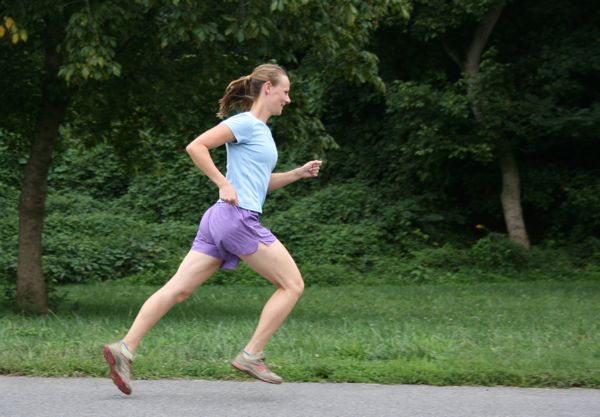
By Pat Reichenbach
Somewhere deep down inside of every runner, there’s a memory of a young child who loved to run just for the fun of it! That child never had sore knees or plantar fasciitis! That child was never taught to run, but could run like the wind with the running form that nature provided. Over time, we’ve replaced that natural running form with an injury-filled sport. But for anyone with an open mind to healthy change, regaining natural running form is a reasonable goal. The ChiRunning® skills will get you there.
Why change the way you run?
Change the way you run to reduce injury. Injuries related to running form include plantar fasciitis, Achilles’ tendon issues, calf pulls, shin splints, stress fractures, knee issues, hamstring tears, groin pulls, piriformis syndrome, IT band issues, hip issues, lower back strain, neck pain.
Change the way you run to improve efficiency. Less effort, less oxygen and less muscle glycogen will be needed. Use the energy saved to run longer or faster or recover more quickly or simply enjoy running more.
What things should you change?
Here’s what you should focus on changing: Poor posture, poor alignment, lack of core engagement, extraneous movements that do not accommodate forward motion, tension in muscles not needed for running, rigidity in joints that should move freely, overuse of muscles in the feet and legs, heel striking, excessive impact.
To improve your form, focus on the skills that served you well as a child. The learning process is fun and very enlightening. Here are a few pointers to get you started.
Good running form is a core issue.
Get started by improving your posture now. Your mother was right! You should sit, stand, and walk tall—not stiff, just tall. It takes more mental effort than physical effort. The effort is worth it. Every time you pull yourself into better alignment you create benefits greater than you realize. You require your core muscles to engage—and believe me, they need the practice. Your core may be perfectly capable, but it’s likely that these muscles are suffering from amnesia. Require your pelvis to be level and core to be engaged on a regular basis. When running, your core will be asked to handle the two important jobs that it was designed to do: stabilize your posture line and produce movement.
Applied Physics
“A body in motion tends to stay in motion unless acted upon by an outside force.” Once you’ve created a strong posture line, then you are ready to let gravity be your means of propulsion. While running, practice allowing a slight forward lean from the ankles and let gravity assist your forward motion. As you become comfortably balanced with this slight forward lean from the ankles, your stride will be shorter because your footstrike lands under you instead of out in front of you. If you place your foot out in front of you, you’ll inhibit the free pull of gravity. Using gravity is applied physics: By allowing your center of mass (your core) to stay slightly in front of your base of support (your footstrike), you become the body in motion that tends to stays motion—just like you did naturally as a child!
Your legs are wheels, not engines.
By cooperating with gravity, you’ll be in a position to let your legs be wheels rather than engines. The function of your legs is to provide momentary support rather than propulsion, so teach your legs to do less work! Allow the road to take your legs rearward, then quickly pick up your feet, bending at the knees to create a circular pattern of motion. No pushing off, no heel strike. Feet, knees and legs are no longer being overused. Most running injuries are reduced or eliminated with this aspect of form change. When you let your legs be wheels instead of engines, your running is more efficient and creates less impact.
Less is more.
Make the choice to implement changes to improve your running form, but take it easy. Make small changes that allow your body to relax and adapt. Big changes or too much too soon can lead to muscle tension and injury. The most beneficial and long lasting changes are incremental and take place over time. Less is more, in the long run.
For complete instruction on how to run efficiently and without injury, read the book ChiRunning by Danny Dreyer and sign up for a ChiRunning Workshop. I’d love to work with you this spring!
# # #
Pat Reichenbach is a certified ChiRunning and ChiWalking instructor, personally trained by ChiRunning founder, Danny Dreyer (www.chirunning.com). She lives in the Raleigh area and teaches workshops in Raleigh, Cary, Durham, Wilmington, and Pinehurst, NC. Pat has a Bachelor of Science degree in Physical Education and is an ACE Certified Personal Instructor and IFTA Certified Senior Fitness Specialist. Pat’s Website is: www.PatsPersonalTraining.com






